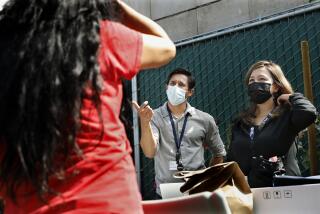L.A. Underclass Hit Hardest by Epidemic
- Share via
In a county choked with swimming pools, sunshine and suburban sprawl, the news of a tuberculosis epidemic seems more like science fiction than fact. Where are the bleak tenements? Where’s the overcrowding?
But an epidemic has crept into Los Angeles County, selectively plaguing its underclass--the newest immigrants, the homeless, drug abusers. It has also moved deeply and rapidly into the AIDS community because people with weakened immune systems are most at risk.
While the general population still remains untouched by what was once called consumption, the rate of growth of new TB cases is alarming.
County health officials predict there will be about 2,000 new cases by the end of 1991, a 10% increase over last year; they also expect the number to double by 1995. Already, new cases among young children, though small in absolute number, doubled last year from 50 to 100.
And like errant missiles warning of a nearby war, scattered reports of TB have been turning up in middle-class neighborhoods. Three Glendale infants were infected with the disease by a baby-sitter working at a church in La Crescenta. In another Glendale case, a housewife came down with TB, but where she picked it up remains a mystery.
“People thought it was cured,” says Karen Dorman, TB project manager at the American Lung Assn. in Los Angeles. “It’s taking time for people to accept that it’s back. They’d rather think it’s a problem with immigrants. I think there is a fair amount of racism connected with people’s attitudes about TB. People feel if they are of a certain race and live in a certain area, they are immune to it. That’s not true.”
Health officials are concerned that local doctors--especially those trained in America since TB has been equated with almost-extinct diseases like typhoid and diphtheria--no longer know how to recognize or treat it.
Cases have been “mishandled in many instances,” says Dorman.
But TB can be hard to detect.
Usually a skin test, called a tuberculin test, is used, but if it is negative and there are TB symptoms, doctors turn to X-rays and sputum smears. Someone with an active infection can develop symptoms such as coughing, chest pain, shortness of breath, fever, night sweats, poor appetite and weight loss. But a person with as severe an infection can also feel nothing more than a case of a mild cold.
The disease is usually treated with isoniazid in combination with other drugs. If treatment is stopped, the disease returns and a person can become resistant to the drugs. It takes two to four weeks of a regular drug regimen for a person to become non-contagious.
“You usually get TB from a close association, usually a member of your household,” says Dr. Paul T. Davidson of the county TB control program. “A one-time exposure usually doesn’t infect a person. The danger is relatively low. It’s not as easy to catch as flu or measles.”
New immigrants who often live in cramped quarters constitute the largest portion of people with TB in Los Angeles County--about 60% of all cases. In Los Angeles, these people come mostly from Latino and Asian countries.
Davidson says the fear of being deported is proving to be an obstacle in cracking the epidemic among this group.
“If they come to our health centers, (illegal status) isn’t a concern at all,” he says. “But many people do not come in until they are quite ill and until the TB has damaged the lung quite extensively and may have spread to other parts of the body as well.”
But the current profile of a typical case may be rapidly changing. The growing number of U.S.-born children being treated for TB indicates the disease isn’t just brought to this country. It is also acquired here, often by children.
“The most horrible of stories have to do with pediatrics,” says Davidson. “TB meningitis (a serious form of TB that irritates the spinal cord and brain) is difficult to recognize because it looks like a cold. Children have high fevers and have symptoms most doctors would not follow through on. What happens is these children are sent home (usually from a hospital emergency room) and end up in coma and have brain damage, if they live.”
Because the upturn of TB caught everyone by surprise, health officials fear the county will be slow to react to the immediate needs; they warn that money is scarce for a public health campaign to put the epidemic in check.
The American Lung Assn. is trying to reach high-risk families by attending health fairs and community events to offer free skin tests and educational pamphlets. Students are required to show proof of a skin test before entering school, but lung association officials remain concerned with identifying younger children at risk.
“The problem is that when you go out and seek to help people, you end up identifying more cases,” Dorman says. “It gets worse before it gets better. But if we don’t put in the necessary funding . . . to deal with it now, it will get worse and stay worse for awhile.”
More to Read
Sign up for Essential California
The most important California stories and recommendations in your inbox every morning.
You may occasionally receive promotional content from the Los Angeles Times.













